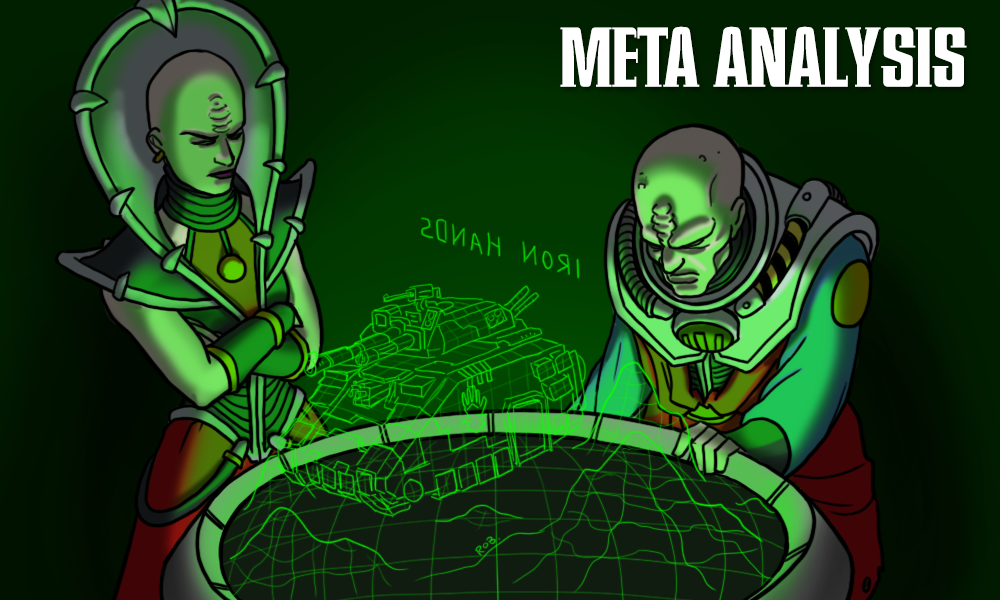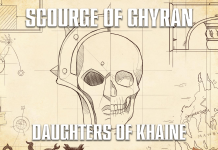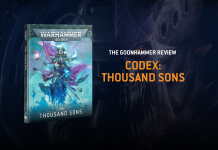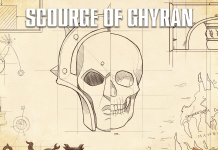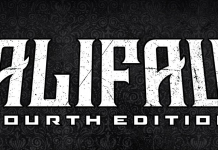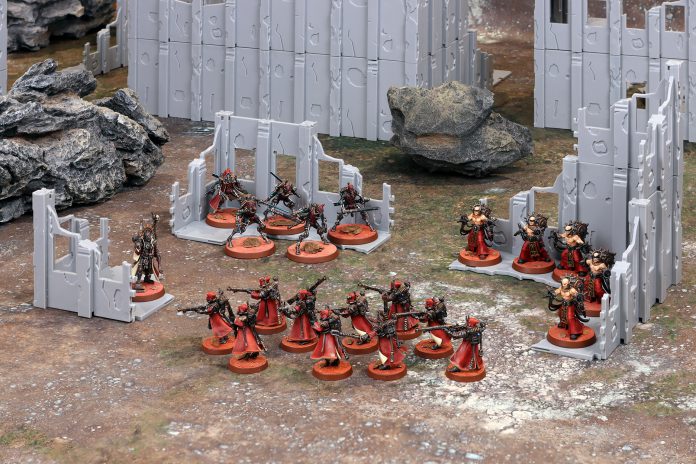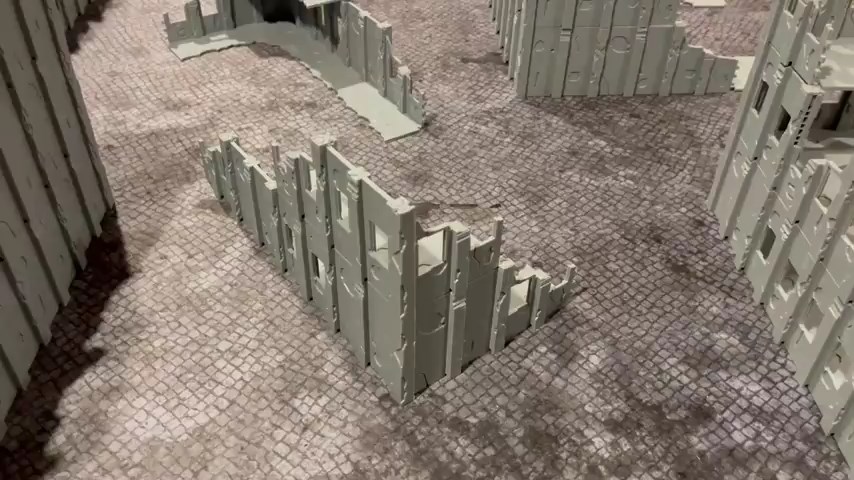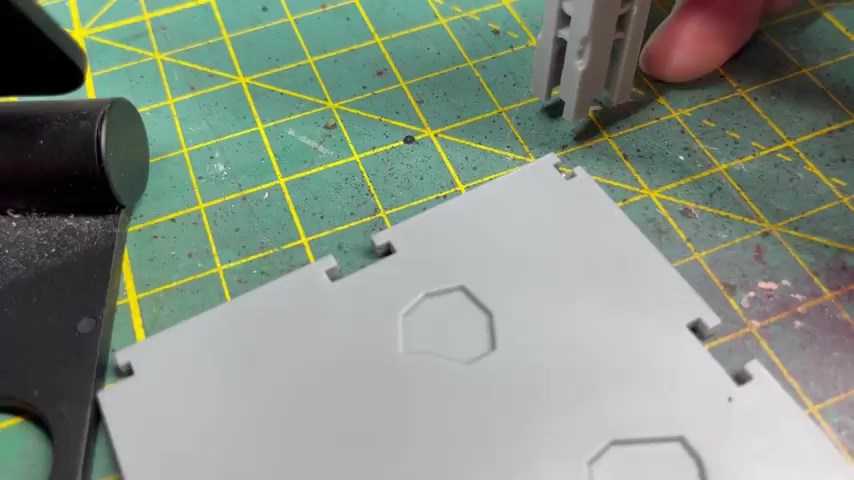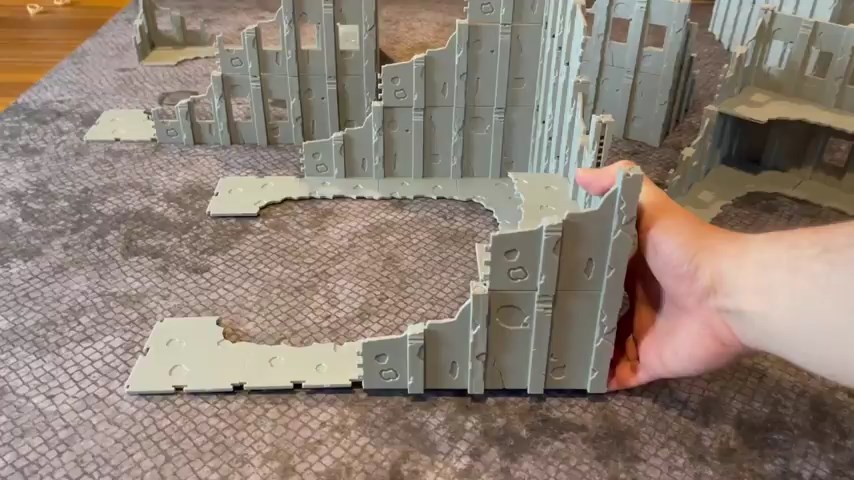Snot Goblin Gaming’s Modular Terrain has launched on Kickstarter, and we’ve been fortunate enough to receive early review copies. Does Snot Goblin Gaming’s terrain pass the sniff test, or does it leave us congested? Grab a tissue, and let’s blow through this review.
Terrain maketh the battlefield, but man maketh the terrain. And let me tell you, sometimes all that maketh-ing is exhausting – hours of clipping, sanding, and gluing terrain, either plastic or MDF, is not everyone’s cup of tea. And after you’ve maketh-ed it all, you have to store-th it, which can be quite the burden. Snot Goblin Gaming’s terrain takes a novel approach on improving this, advertised as “Think LEGOs – but for tabletop terrain”.
Like LEGOs, this plastic terrain is made of small plastic pieces that fit together without glue. Most pieces, like pillars and walls, are simple push-fits. Though floor segments require a small connecting piece to fit together, and each pillar has either a cap on the top or a small connecting piece to secure it to the pillar above. And like LEGOs, it can be fully disassembled, tossed into a bag or shoebox, and stored just about anywhere.
There’s plenty to say about this terrain – the good, the bad, and the ugly. No single person is going to have all the answers, or opinions that directly align with your own. That’s why several of us here at the Goonhammer Corporate Offices have been looking at this terrain, each from a different perspective.
That’s right, this pinball machine of a review just locked in a MULTI-REVIEW.
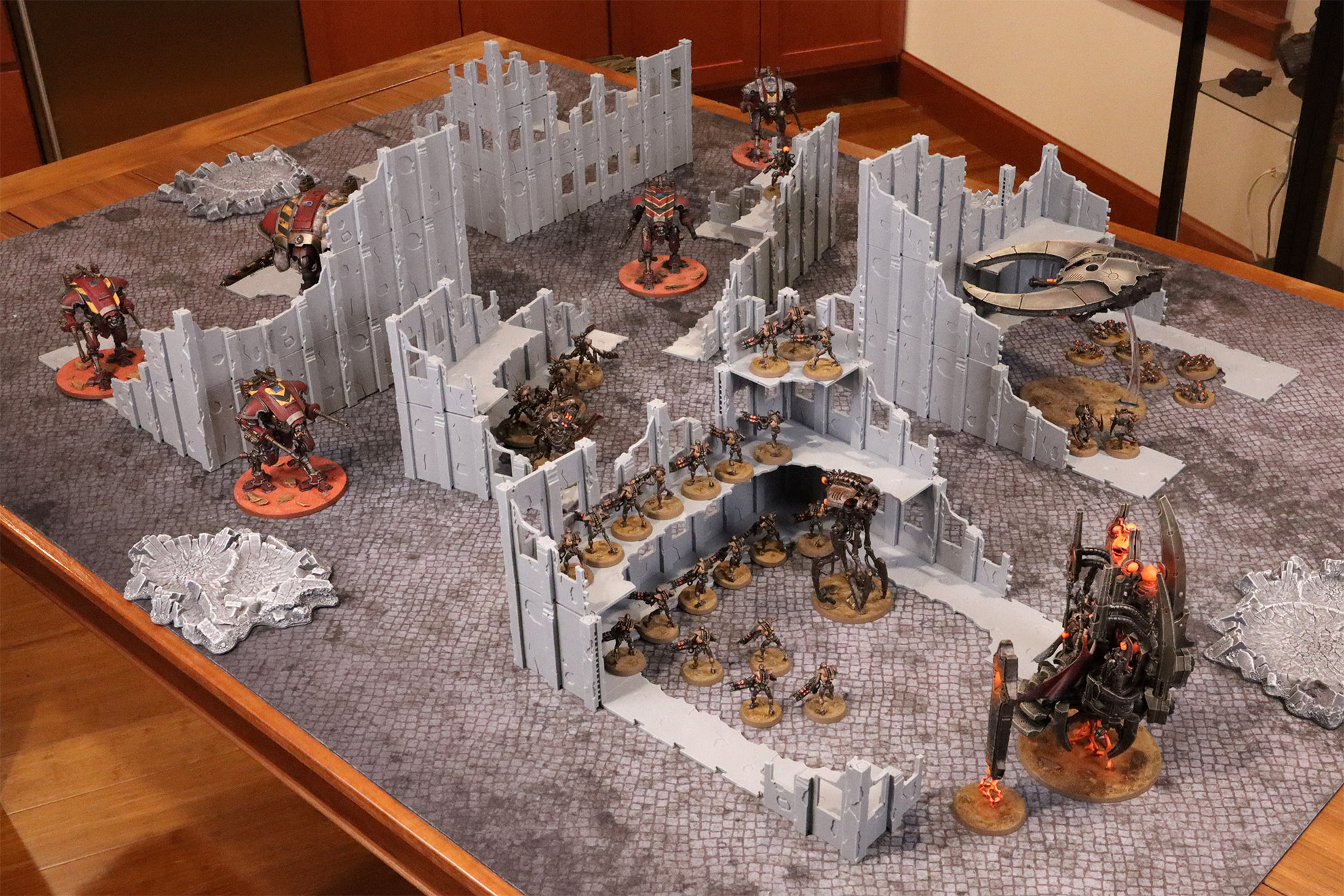
Pendulin
It’s me – I’m the guy that loads up a giant, heavy box of terrain and hauls it to my FLGS for games. It sucks, but I like having a fall back in case my FLGS’s terrain has been picked clean and I’m left with scraps. “Your attack is going over that sheet of bubble wrap, so I gain Dense Cover, and last round I toed-in to that soda can for Light Cover.”
The idea of replacing this with a small, light-weight set of terrain is intriguing. It being modular also draws me in, as playing with the same static ruins, game after game, can get repetitive. So with interest piqued, it’s time to open the box and dive in.
Inside the box, you are treated to a smorgasbord of plastic walls, pillars, and floors. As I was given a review copy, I don’t know what the Kickstarter packaging will be like. My copy was packed in simple zip-lock bags and, honestly, that was perfect. I don’t need a fancy vacuum-formed plastic shell or styrofoam packaging. Give me some bags, no muss, no fuss.
Assembly isn’t complicated, other than a couple fiddly bits which I’ll get back to later. There are some handy assembly instructions on Snot Goblin Gaming’s site, which I recommend going over first. It’s not complicated, but it’s good to have an idea of what you’re building towards.
The first building I assembled, a large 12” square U-ruin, took about 20 minutes, and a lot of that was learning how stuff fit together. After putting together a couple ruins, I found I could reliably go from “bag of pieces” to “finished building” in less than 10 minutes. The narrow L-ruins were quicker still, taking only about 2 minutes each. All together, you could go from a shoebox of completely disassembled plastic to a full 60×44 table of terrain in well under an hour.
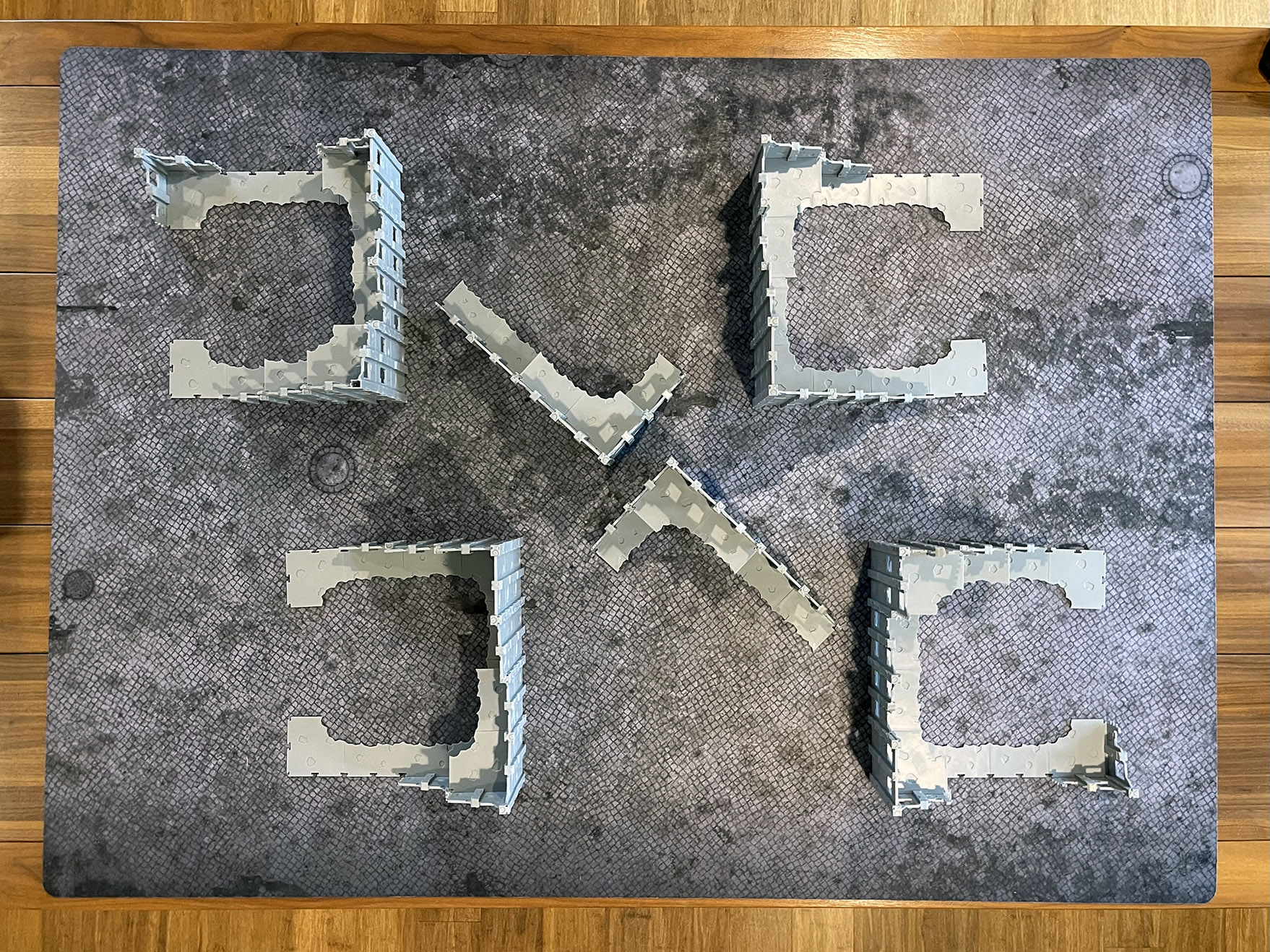
Build time is one of the first tradeoffs with this terrain. Big and bulky MDF terrain is, well, big and bulky. But big MDF buildings can be as fast to set up as they are to grab off the shelf. You could set up an entire battlefield with pre-built terrain before your opponent finishes unpacking their army, but you might be hard-pressed to assemble a single building of modular terrain in that time.
However, don’t take that as a complaint. That’s the tradeoff you buy into with this terrain. Bulky terrain is fast to set up only if you have convenient storage space for it, and some of my bulkier terrain is HUGE! That means I need HUGE STORAGE SPACE!
Snot Goblin Gaming terrain, on the other hand, collapses small. Really small. With this terrain, I could store an entire battlefield in my fridge’s vegetable drawer. I could pack an entire battlefield into a pillow case, toss it on my bed, and have the worst night of sleep of my life.
If your storage space is at a premium, this is terrain you should look at. And if you can spare a bit more room, then this terrain can meet you halfway. If you leave the terrain in subassemblies, large flat sections of walls and floors partially assembled, then you can flat pack it like that. You’ll need a bit more storage space for this, but less than you might think. The benefit of subassemblies is that, in my experience, it cuts build time in half.
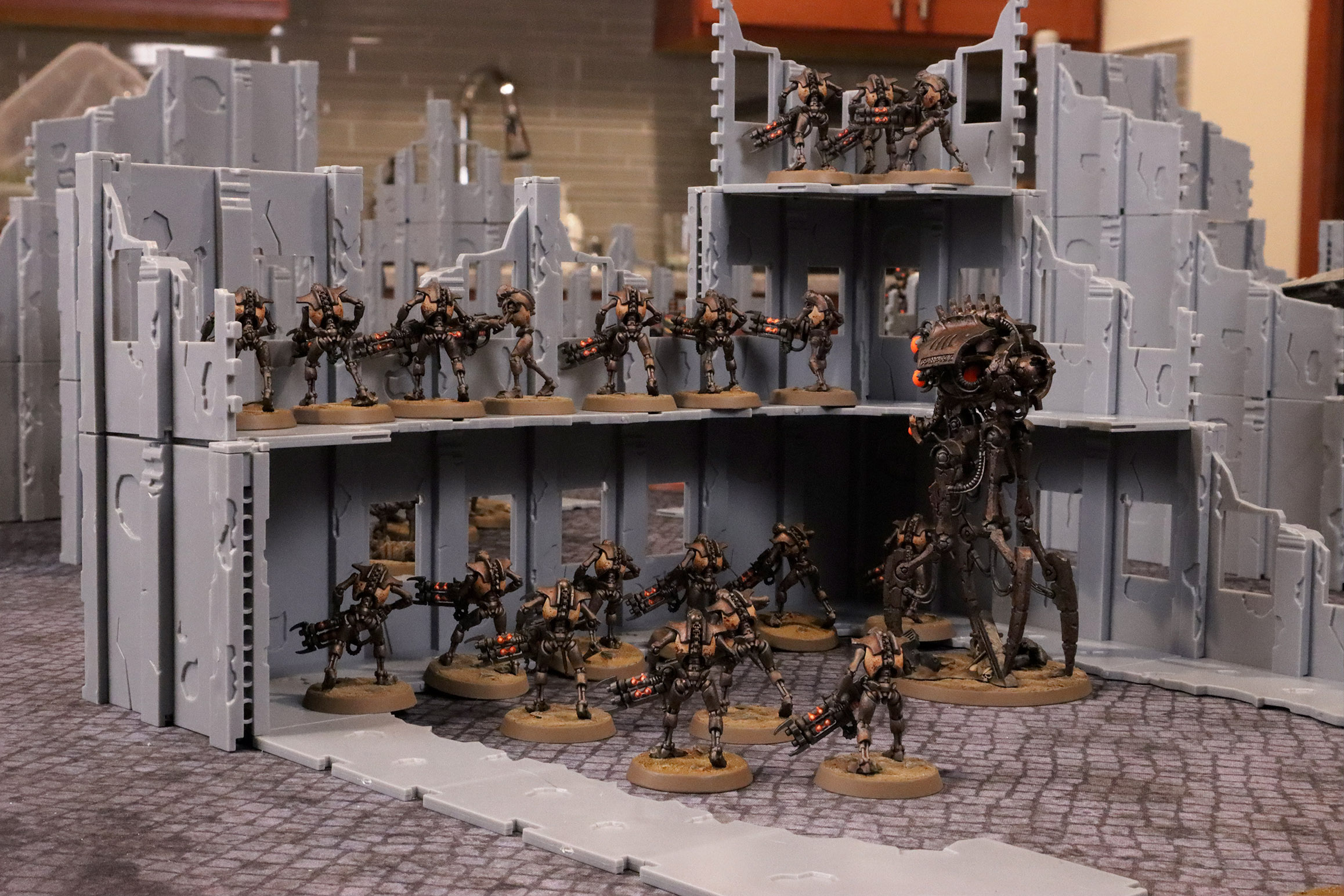
Does cutting assembly time in half make it quick enough to assemble at the FLGS before a game? That’s a bit iffy. It’s fast, but when I’m rushing to get a game in on a weekday night, I don’t want to assemble terrain with the precious little time I have. That being said, you can always transport this terrain fully assembled. Pop a couple of the floor outcroppings off (another thing I’ll get back to later), toss everything in a large cardboard box, and head out the door. Sure, you’re not taking full advantage of it being modular, but your back will thank you when you don’t have to haul a 25lbs box of teetering resin terrain up a couple flights of stairs.
As for it being modular, that’s another perk to consider, so much so that “modular” is literally the first word of the Kickstarter title. It’s packaged so that each bag assembles into the bespoke square- and L-ruins you might be familiar with. But pieces are pieces, and you can assemble it any way you want. Well, almost any way. You’re stuck with box-shaped buildings, no zigzagging walls – at least if you want flooring to go with it. And while you technically could just keep building up and up and up, you’ll hit a practical limit on how big you can make a ruin before you, well, ruin it. Fortunately, that upper limit is far above anything you’ll want to use in a real game.
You can also build smaller and smaller ruins, down to structures that are just a single corner, two wall segments, and a single flooring tile. As you might expect, owing to some inverse-square law or another, these smaller structures are extremely durable. Even the L-ruins, which are 6×12”, are surprisingly durable – on a level I would expect of fully-glued plastic terrain. It’s genuinely impressive.
However, it’s not all sunshine and roses in the grimdark future. While the smaller ruins are sturdy, there are some issues that crop up on the larger ruins. In part, due to some design decisions made on the fiddly bits. Told ya I’d get back to the fiddly bits later, and here we are: the aforementioned later.
Some of these components are designed in a way that I feel could have been improved. But rather than handwave this, let’s go over some specifics. Specifically, pillars and floor tiles. Even specifically-er, there are two kinds of pillars – straight and 90 degree corners – and neither are rotationally symmetrical.
For straight pillars, you have to do a quick check to see which end is “up” and which is “down” by finding the end with the notch. The notch is always down. Easy enough instruction to follow, but it also feels unnecessary. I feel like the design of the straight pillars was only an iteration or two away from being rotationally symmetrical. It’d likely require some changes to the pillar caps, but again, it feels like the optimization was right there waiting to be made. However, the design of the straight pillars is a small gripe. Once you learn “notch = down”, you never have to think about it again.
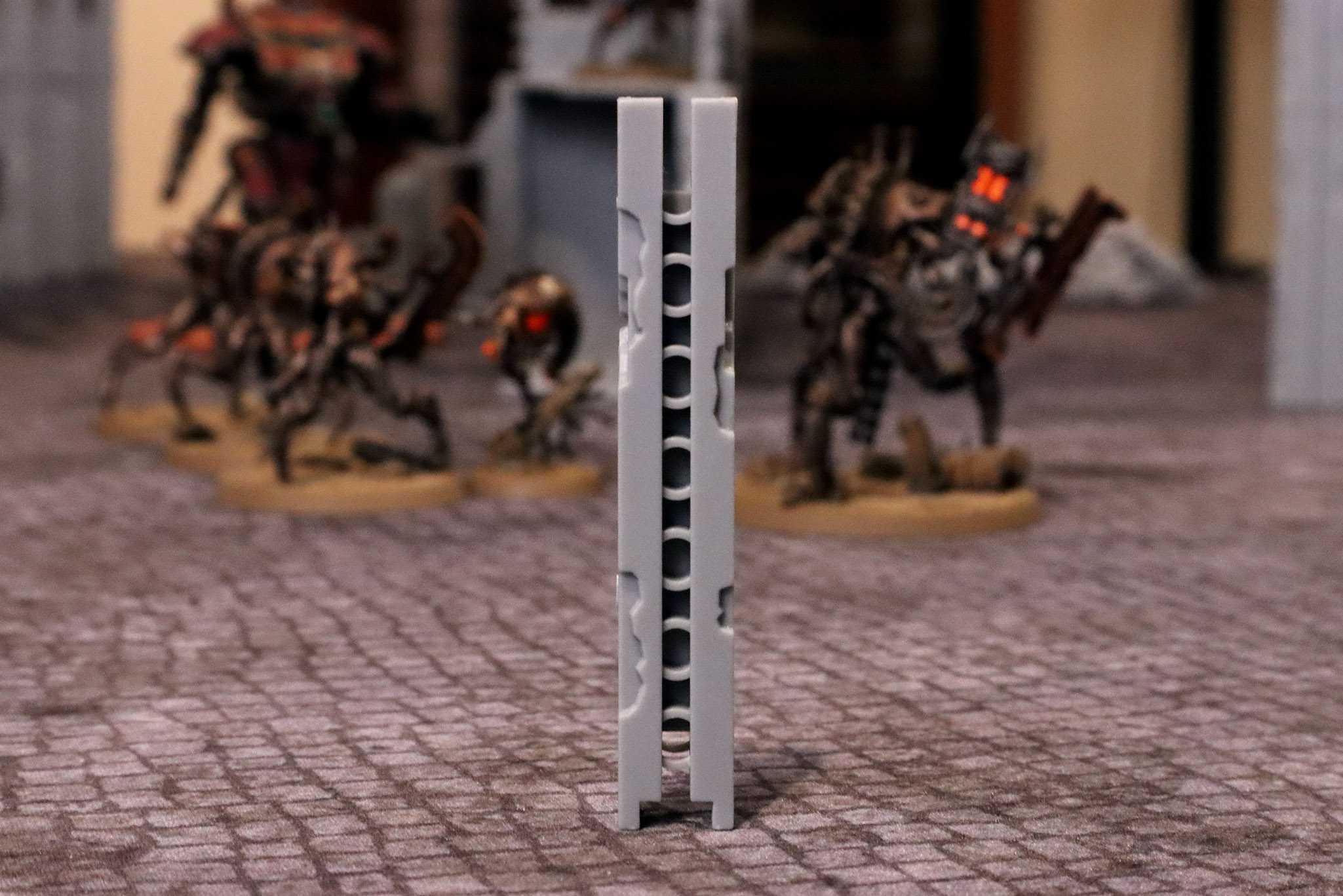
For corner pillars, though, it’s more complicated. Like the straight pillars, these aren’t rotationally symmetrical. But there isn’t a simple notch to look for, nor an “up” end and a “down” end. Instead, you orient it by whether it’s a “left-hand” corner, or a “right-hand” corner. If that sounds vague and confusing, yeah. You got it. This is one that I messed up quite a few times when rushing to assemble a battlefield, leading to some moments of frustration where I had to tear apart a ruin just to flip a single corner pillar.
To be clear, I’m not a product design engineer. Looking at these pieces, I fully well understand how they fit together, and honestly it’s a clever design. If you forced me to load up Blender and come up with something better, you’d find me huddled in a corner ten minutes later, mumbling to myself about object mode and orthographic camera projections. But that being said, it’s nonetheless frustrating when you mess up building a corner for the third time in a row.
A Quick Aside – August 29th 2022
The review copies we received include a preproduction version of the pillars. These pillars were produced with connectors that are are too tight and, especially with corner pillars, really take some elbow grease to connect walls. For corners pillars, it can require “it feels like I’m doing it wrong and am going to break it” levels of force. Snot Goblin Gaming was upfront and honest about this issue, letting us know that this issue only affects review copies and that Kickstarter copies are made using an updated pillar model which doesn’t have this issue. An updated set of pillars is on its way to the Goonhammer Corporate Offices for review, but we haven’t yet gotten our hands on them. We’ll be sure to update this review when we check them out.
A Quick Update – September 2nd 2022
We’ve received an updated set of pillars, the same that will ship with Kickstarter orders, and have confirmed that they entirely resolve the issues we found in the preproduction pillars. The pillars require about as much force to push together as LEGO pieces, which feels natural when constructing the terrain. With the updated pillars, walls are held in place just as securely, if not more so, than with the preproduction versions. Good stuff.
The last fiddly bit is the floor connector piece. More than anything else here, this is furthest from that “Think LEGOs” philosophy. With LEGOs, you push bricks together, and that’s the mechanism by which they are attached. With these floor tiles, you slide a plastic shim into one floor tile, and then you attach that to the other floor tile, with the shim keeping them together. It feels a bit out of place, but that’s not really my complaint. My complaint is that the flooring connections are durable until they aren’t.
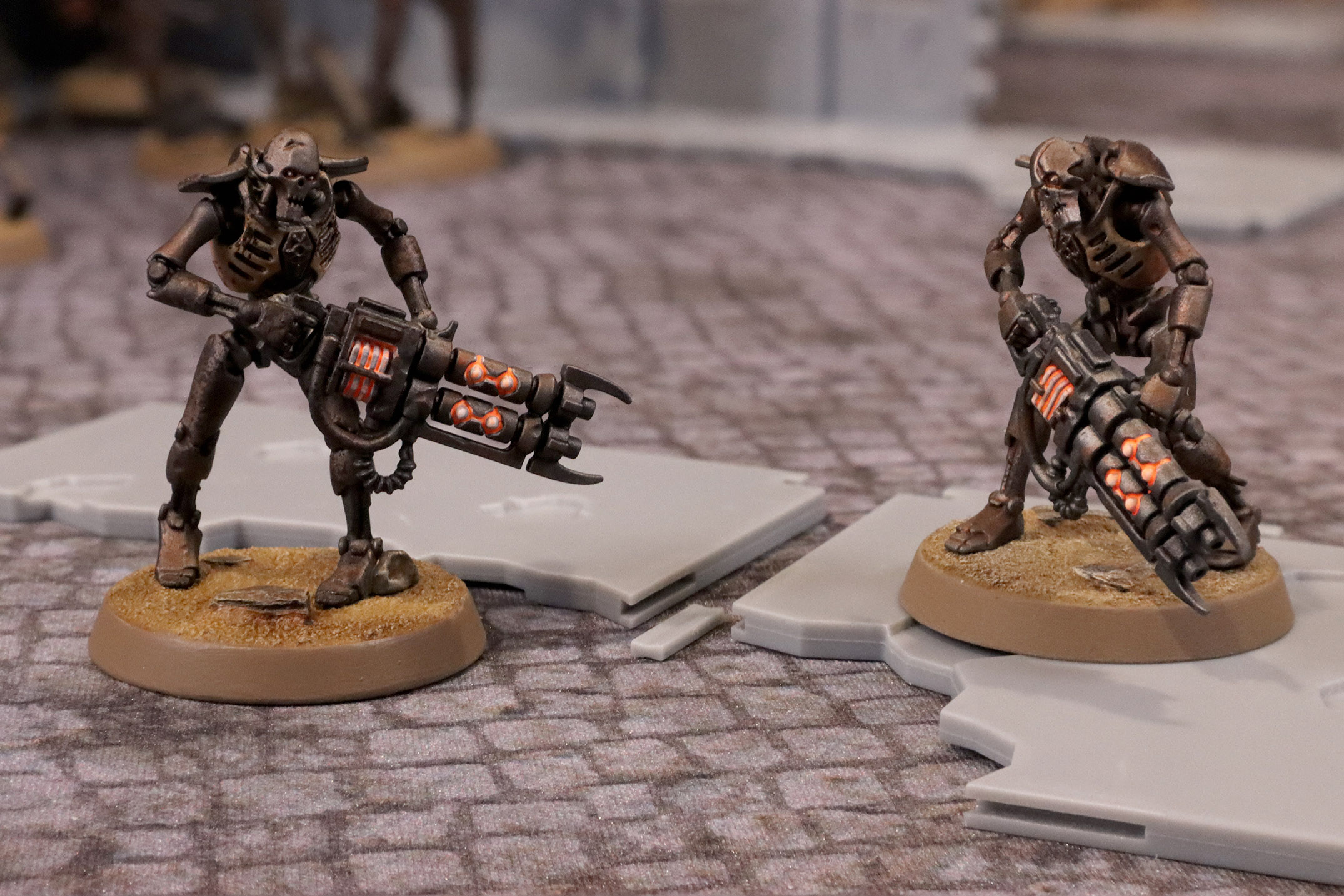
Let’s go back to the sturdy L-ruin for an example. In this, each floor tile is directly linked to a wall, which is then linked to other walls and other floor tiles. And those connections make the whole thing, floor tiles and all, feel extremely durable. The L-ruins are absolutely solid. However, the square U-ruins are not quite the same.
See that floor outcrop that is bowing a bit? By virtue of how these ruins are shaped, they frequently have sections where multiple floor tiles are attached to each other without any supporting walls or pillars. These floor outcrops are the least durable part of these ruins by a considerable margin.
And if the ruin is separated, with only floor tiles attaching distant parts, then you have to take care when picking it up. Two hands is a must in some cases.
That looks worse than it is (sounds worse too), but it was only a mild inconvenience. Nothing broke, and I reattached it in in just a couple seconds. But it’s still something you want to be aware of when picking up and moving the terrain. It’ll handle some occasional abuse just fine, but you wouldn’t want to make a habit out of carelessly handling it.
Another Quick Aside
Reached for comment about this, Snot Goblin Gaming mentioned that there’s a solution in the works – quarter-height walls and pillars. These could be used either for aesthetics or for structural reinforcement in situations like the above two clips. We haven’t reviewed these, but on a conceptual level they seem like a slam dunk and have the potential to entirely solve this issue.
With all that negativity, does that mean I dislike this terrain? Not at all. I’ll find complaints about anything. Mona Lisa? Too small. Serberys Raiders? Too expensive. The Mars Volta’s debut album De-Loused in the Comatorium? Okay, that one is perfect, no complaints.
And similarly, I have no complaints about the look and feel of Snot Goblin Gaming terrain. It looks precisely like how it’s advertised, and you already know whether or not that look is an aesthetic you enjoy. It feels more durable than you’d expect from push-fit terrain (baring the floor outcrops). The price is on-par with other “full battlefield” terrain sets, but the biggest selling point is the weight, portability, and storage size. You could probably store an entire battlefield of terrain in a pair of Combat Patrol boxes. That’s simply wild, and if “I want terrain, but I have nowhere to store it” is a thought you’ve had, then you should think about looking at Snot Goblin Gaming’s Modular Terrain.
Muggins
At first I was a little intimidated – there are a TON of pieces in the box! Once I figured out how to put one set together, though, it really didn’t take me long to figure out the others. I imagine I spent about thirty minutes figuring out the first set, and then when I went to put that set together again it took five minutes.
I really like how tough the set is. It’s hard plastic and the pieces that are interlocking are well-made. I tried pulling stuff apart a few times and when it did come apart, it didn’t snap or even bend with the little plastic ‘give’ marks that you usually see – it just came apart and the pieces came through like a champ. I could see these sets lasting a long time.
I think it’s great that the sets don’t include any kind of iconography – while I know these are made for tournament gaming of 40k (and they work great for that!) you could use these for pretty much anything – including a ruined city in Bolt Action, Necromunda, Firefight, etc. I plan on texturing mine a little then airbrushing it to work with any of the above.
Another aspect that I love is the height of the kits. You can make some absolutely huge terrain pieces with this kit that will block LOS not only abstractly, but for true LOS as well. They’re pretty well grounded so they won’t fall over and hit a bunch of stuff, either.
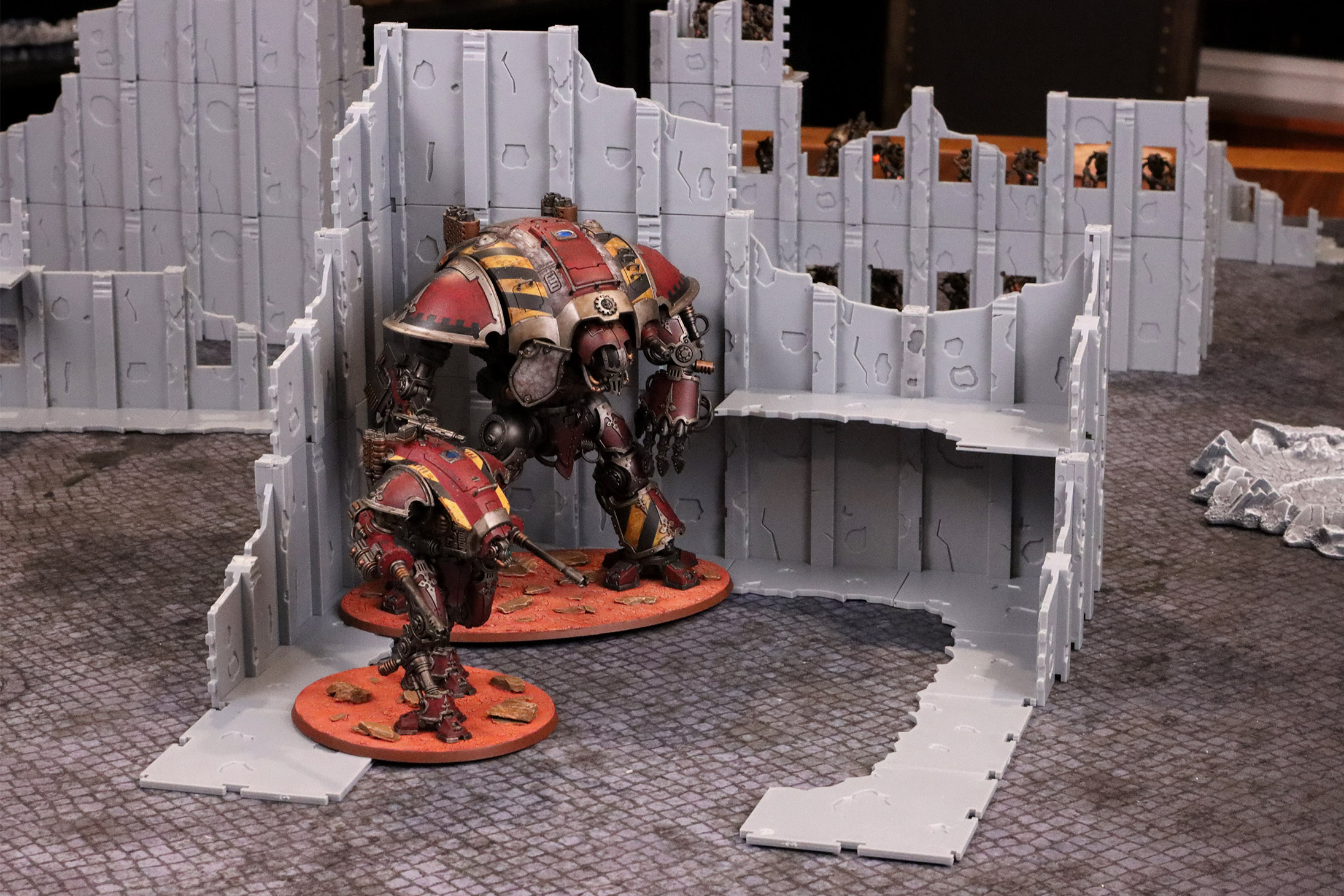
In terms of portability, I think I’d probably follow Pendulin’s guidance above and leave some parts together and throw them in a box. One of the biggest headaches I have at my Goon Compound is that I have a bunch of terrain on shelves in the garage. It gathers dust out there and I have to brush them off when I use them. I could throw them in totes ($$). With this solution I can toss it in a box, put a little tape over it and the dust won’t get in. Perfect.
If I had a few issues with the kits – the corner pieces were a bit confusing to me. I didn’t watch the right video first so I really didn’t grok the difference between them so I put them on wrong the first few times, and when I went to line up levels it didn’t work. Once I had it figured out I could then do it right the first time but it took a minute. Wall pieces also have a top and bottom and that took me a minute to figure out – they weren’t totally symmetrical.
The ‘caps’ that you can put on top of walls to cover open parts took a bit of fidgeting on some of the joins to get in correctly – I think it’s a case of making sure you push the walls in totally far enough to click in.
The only other issue I could think of was that some walls are left un-connected – and it shows the little join pieces that click together. I’d love if they could offer something to cover those up.
Ellarr
I am coming at this from a different perspective than my colleagues here, in that I was primarily drawn to one particular element of the five second pitch:
Think “LEGOs”– but for tabletop terrain! Compatible with Warhammer 40k, Age of Sigmar, Killteam, Dungeons and Dragons, and more!
If you follow my writing on the site, you know that I primarily write about Age of Sigmar, and it immediately got my attention because for the longest time AoS has not really been offered terrain like this.
To clarify, there is a lot of terrain out there that is compatible with Age of Sigmar, as the scope of that world is so large and fantasy so broad a category (not to mention overlapping somewhat with Dungeons and Dragons stylistically) that you could pretty easily crowbar any kind of terrain you liked into the setting. That said, the problem that I’ve always had with fantasy terrain is that it’s largely focused on style and not very focused on function on the tabletop.
It’s important that I give proper context before I talk about this terrain, so stay with me for a sec. Most fantasy terrain that is available out there isn’t actually all that great for gameplay within Age of Sigmar. GW’s own Wyldwoods work well enough because they have a clear and defined function within the core rules of the game, but when you try to apply the core rules to their other terrain offerings you immediately start to see problems.
Primarily, it’s that they don’t really make very good ‘area’ terrain, so getting cover in Age of Sigmar is very difficult indeed. Units must either be within 1″ of the terrain or directly behind it, which for most units and base sizes is comically difficult to achieve if your unit is larger than 5 models.
In addition, the mystical terrain rules specify that models must be within 1″ of the terrain feature, and when many third party solutions are tall wizard towers, or individual trees, or just straight up box houses… it becomes very difficult to actually attain these bonuses without making the unit seeking to receive them useless for the game itself. For that reason, I was interested in these ruins because they offered large footprints and could feasibly work within the core rules to offer the benefits of cover and mystical terrain bonuses without compromising the look and feel of the game.
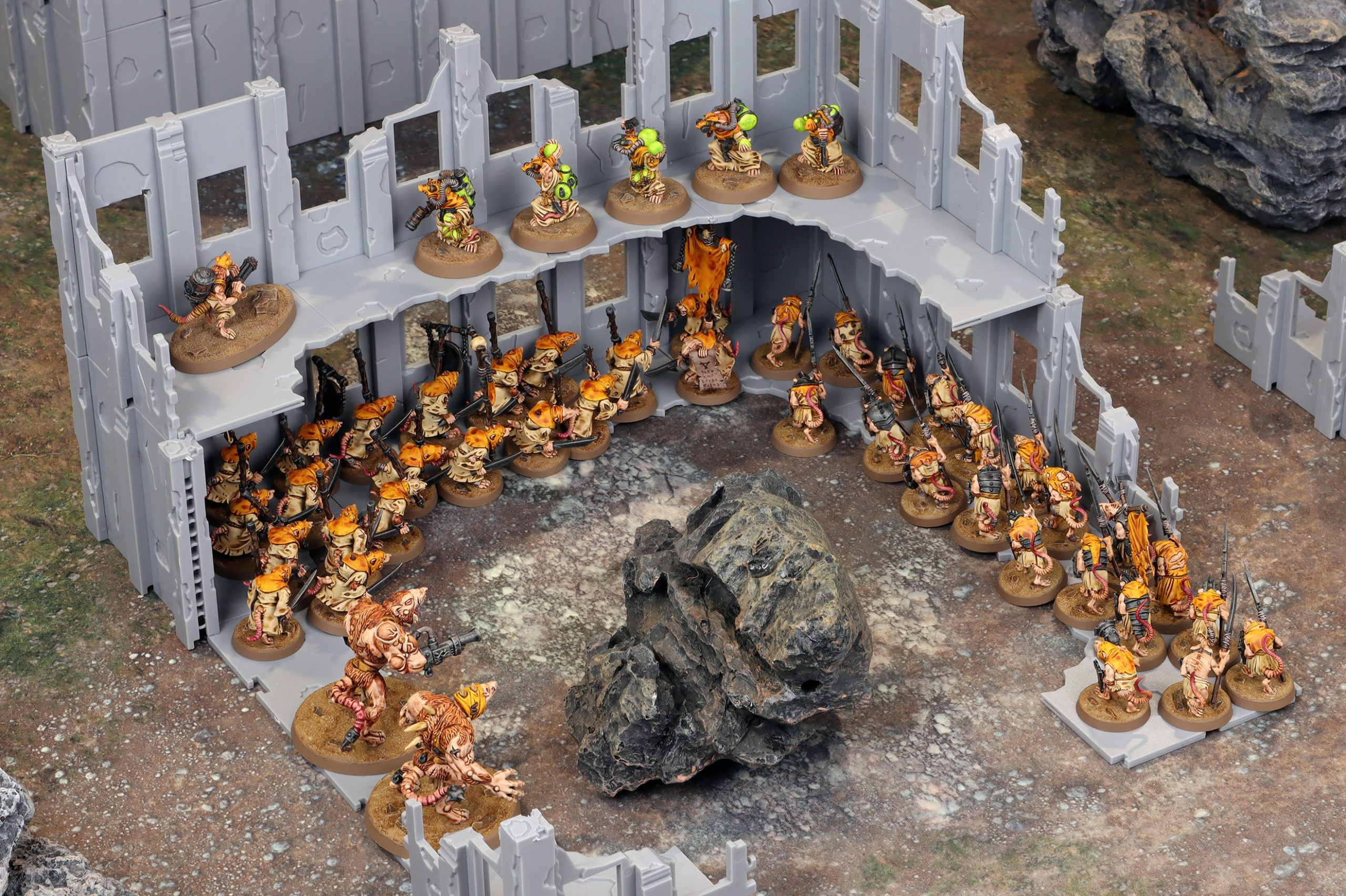
Onto the terrain itself – I’ve built the U ruins both with and without windows a few times, and my immediate impression is that this is definitely *not* Lego. That’s not to say that it isn’t straight forward to put together – it mostly is after a few growing pains, but Lego is almost unconscious in it’s ease of use, whereas a lot of the connections you have to make with these pieces require a level of patience and finesse that a child playing with Lego simply doesn’t have. That said, as a functional build up and tear down set of terrain it is pretty straight forward to use and is actually kind of fun to mess around with.
I was pleased with how they looked when they were built together, though I’ll echo Pendulin’s comments on the relative flimsiness of some of the floor pieces – once you’ve made them and set them down on the table; picking them up and re-arranging them requires a degree of care you might not initially expect. That said, this is largely nitpicking because the upper sections and the walls are as sturdy as equivalent ruins bonded with poly cement or super glue, which is impressive considering they can easily be taken apart and stored in a very small footprint box.
As for Age of Sigmar, they look the part well enough on the table when blended with fantasy terrain, though my pieces remain unpainted for the moment which does make them stand out a bit. I think if you were to paint them plainly then they would stick out like a sore thumb, but I’m planning on adding some moss weathering, a little bit of texture paint around the bottom and some vines to make them feel like ruins from a Dawnbringer settlement reclaimed by nature. Are they perfect in terms of aesthetic for fantasy? No. But they at least provide enough of a blank canvas that it would be very easy to jazz them up a bit to fit whatever theme you’re going for. Mine will have Kragnos graffiti and the odd chaos star, for funsies.
In terms of gameplay, I do think that each U ruin is perhaps a little big for 2000 points play considering that the matched play pack suggests each table use 8 terrain pieces, and these bad boys take up considerable space if built in the default configuration. This is problematic when you consider that terrain must be 3″ away from other terrain pieces and objectives in Age of Sigmar. Not a problem if you’re planning on using just two pieces centrally, but if you’re opting to splurge on a larger pack of terrain than you might consider getting less of this stuff but just making smaller footprint ruins. I found that my gameplay flowed better if I cut out some of the floor pieces to essentially make the U shape shallower. This had two benefits – the first was that the footprint was smaller and thus better worked within the battlepack itself, but it also meant that the ruins were sturdier as they had little to no floor pieces without supporting pillars, meaning I could pick up and re-arrange terrain without worrying about the ruin coming apart and requiring field repairs.
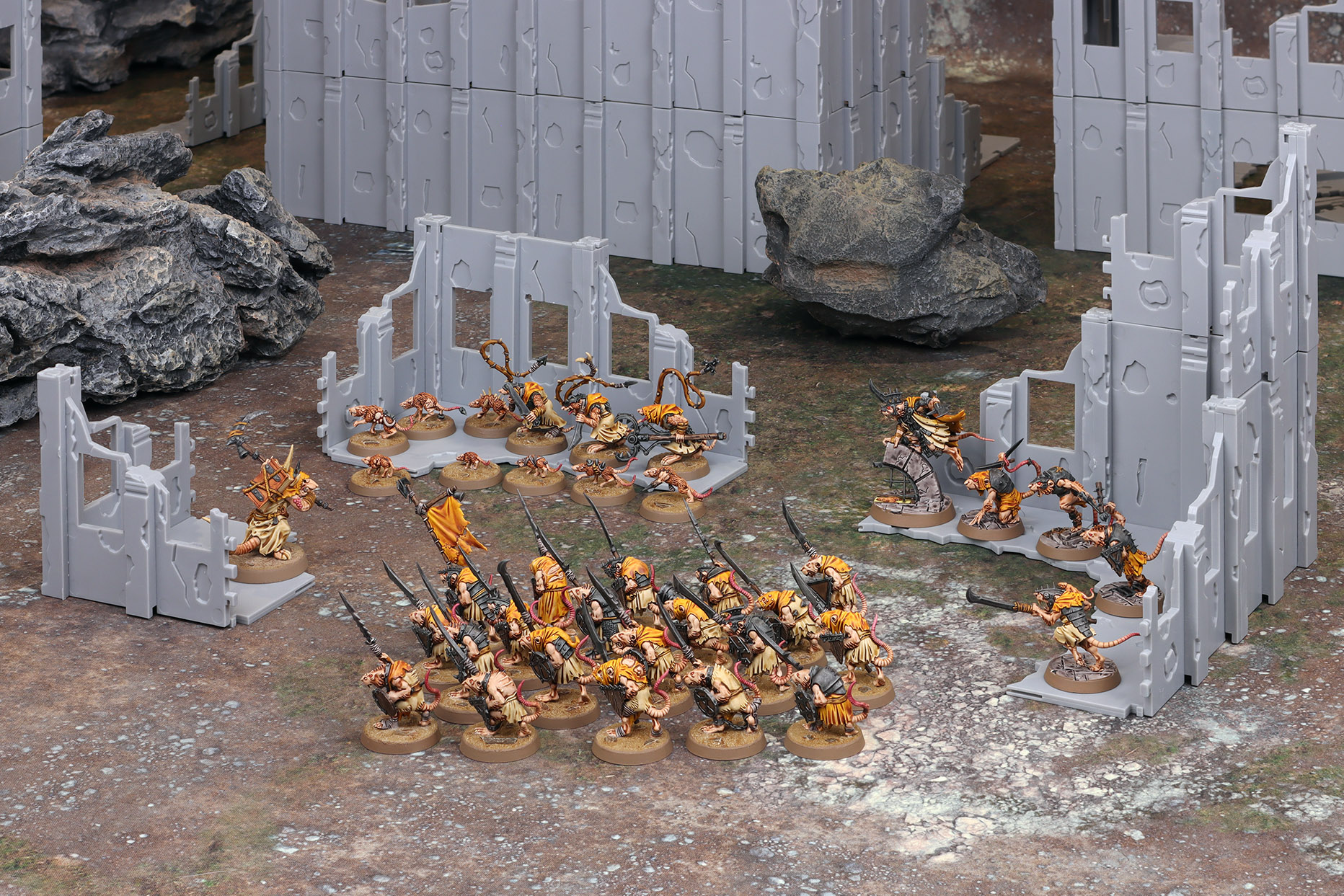
That’s easily my favourite aspect of this kit: I can adjust the size, height and footprint of the terrain to either be the primary centerpieces of the table, or smaller but supplemental pieces for other terrain to take centre stage. If I wanted the main focus of my table to be hills and forests, I could simply chop and change to make my already painted set of terrain smaller and leaner. That’s a level of versatility that traditional terrain kits does not offer, and means I’m likely to keep bringing these pieces to the table for game night.
Final Thoughts
Snot Goblin Gaming’s Modular Terrain offers something that we here at the Goonhammer Corporate Offices haven’t seen before – tournament-style terrain without tournament-style storage. Though setup has a bit of a learning curve and takes some work, the reward is terrain that can fit neatly into the competitive scene, or be rebuilt into something wholly unique. You can pop a wall off here, add a floor there, and create a battlefield that’s new, interesting, and tailored to the game experience you are looking for.
On the table, this terrain is more more durable than you’d expect. Modular terrain might conjure images of flimsy tiles that fall apart in a stiff breeze but, aside from issues with dangling floor tiles, this terrain will hold it’s own next to traditional MDF or glued plastic terrain.
Should you pick up this terrain? You have to answer that question for yourself, as it depends on what you are looking for in battlefield terrain. But if you’ve been looking for a way to cut down on storage size without sacrificing gameplay, or looking for a highly customizable battlefield in a single box, then you might find that in Snot Goblin Gaming’s Kickstarter for their Modular Terrain.
Updated on September 2nd, 2022: This article originally included an aside about an issue present in the preproduction pillar pieces. We’ve since reviewed an updated version of the pillars, the same that will be sent in Kickstarter orders, and have confirmed that the preproduction issues have been resolved. The original aside is still present, but has been struck-through, with an updated comment below the original.

